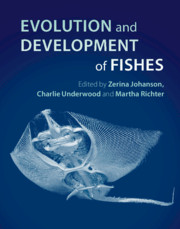Book contents
- Evolution and Development of Fishes
- Evolution and Development of Fishes
- Copyright page
- Contents
- Contributors
- Introduction
- 1 The Evolution of Fishes through Geological Time
- 2 Comparative Development of Cyclostomes
- 3 The Ordovician Enigma
- 4 The Evolution of Vertebrate Dermal Jaw Bones in the Light of Maxillate Placoderms
- 5 Doliodus and Pucapampellids
- 6 The Evolution of Endoskeletal Mineralisation in Chondrichthyan Fish
- 7 Plasticity and Variation of Skeletal Cells and Tissues and the Evolutionary Development of Actinopterygian Fishes
- 8 Origin, Development and Evolution of the Fish Skull
- 9 Evolution, Development and Regeneration of Fish Dentitions
- 10 Development of Head Muscles in Fishes and Notes on Phylogeny-Ontogeny Links
- 11 Evolutionary Development of the Postcranial and Appendicular Skeleton in Fishes
- 12 Evolution of Vertebrate Reproduction
- 13 Links between Thyroid Hormone Alterations and Developmental Changes in the Evolution of the Weberian Apparatus
- 14 Pharyngeal Remodelling in Vertebrate Evolution
- 15 Evolution of Air Breathing and Lung Distribution among Fossil Fishes
- Index
- References
5 - Doliodus and Pucapampellids
Contrasting Perspectives on Stem Chondrichthyan Morphology
Published online by Cambridge University Press: 31 December 2018
- Evolution and Development of Fishes
- Evolution and Development of Fishes
- Copyright page
- Contents
- Contributors
- Introduction
- 1 The Evolution of Fishes through Geological Time
- 2 Comparative Development of Cyclostomes
- 3 The Ordovician Enigma
- 4 The Evolution of Vertebrate Dermal Jaw Bones in the Light of Maxillate Placoderms
- 5 Doliodus and Pucapampellids
- 6 The Evolution of Endoskeletal Mineralisation in Chondrichthyan Fish
- 7 Plasticity and Variation of Skeletal Cells and Tissues and the Evolutionary Development of Actinopterygian Fishes
- 8 Origin, Development and Evolution of the Fish Skull
- 9 Evolution, Development and Regeneration of Fish Dentitions
- 10 Development of Head Muscles in Fishes and Notes on Phylogeny-Ontogeny Links
- 11 Evolutionary Development of the Postcranial and Appendicular Skeleton in Fishes
- 12 Evolution of Vertebrate Reproduction
- 13 Links between Thyroid Hormone Alterations and Developmental Changes in the Evolution of the Weberian Apparatus
- 14 Pharyngeal Remodelling in Vertebrate Evolution
- 15 Evolution of Air Breathing and Lung Distribution among Fossil Fishes
- Index
- References
Summary
In several recently published phylogenetic analyses, two Lower Devonian taxa, Doliodus and Pucapampella, both fall on the chondrichthyan stem, very close to the base of ‘conventionally defined chondrichthyans’ (i.e., forms possessing tessellated mineralization of the cartilaginous endoskeleton). These two taxa nevertheless exhibit strongly discordant morphologies from each other. A summary of the anatomical data concerning these taxa is presented here, including new, as well as previously published, findings. A new family Pucapampellidae is erected, containing Pucapampella and a newly recognized genus from South Africa. Morphological evidence is summarized for the monophyly of crown elasmobranchs (sharks and rays), holocephalans (chimaeras) and other chondrichthyans. Based on these data, Doliodus and pucapampellids both fall outside the chondrichthyan crown, but their relative phylogenetic positions on the chondrichthyan stem are unclear. Pucapampellid interrelationships are particularly hard to assess because little is known beyond their cranial and visceral arch morphology and also because pucapampellids possess a suite of ontogenetically primitive (and thus potentially neotenic) features. By contrast, the phylogenetic position of Doliodus seems less elusive; it possessed an ‘acanthodian-like’ complex of dermal spines, including pectoral fin spines, prepectoral, admedian, and prepelvic spines, and possibly dorsal and pelvic fin spines, in conjunction with numerous ‘chondrichthyan-like’ endoskeletal features and a heterodont ‘sharklike’ dentition. Doliodus can be viewed as a quintessential component of the evolutionary transition between ‘acanthodians’ and ‘conventionally defined chondrichthyans’, leaving little doubt that the chondrichthyan total group includes ‘acanthodians’ (now widely perceived to be a paraphyletic group, populating the basal part of the chondrichthyan stem). Although Doliodus has been resolved as a basal member of the ‘conventionally defined chondrichthyans’, it could occupy a more basal position on the chondrichthyan stem.
- Type
- Chapter
- Information
- Evolution and Development of Fishes , pp. 87 - 109Publisher: Cambridge University PressPrint publication year: 2019
References
- 6
- Cited by

